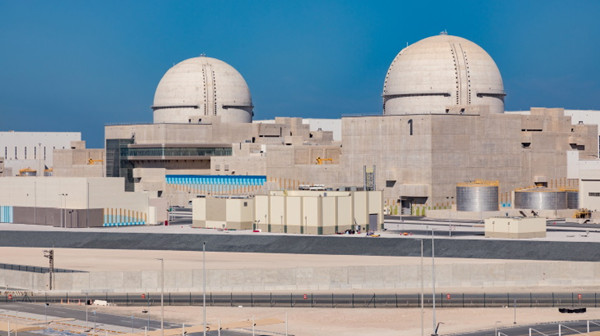UAE completes construction of Barakah 2
The Emirates Nuclear Energy Corporation (ENEC) has completed the construction of unit 2 of the Barakah nuclear power plant. The unit, which is in the Al Dhafra region of Abu Dhabi, has been officially handed over to ENEC subsidiary Nawah Energy Company, which can now start preparations to obtain an operating licence for the unit from the Federal Authority for Nuclear Regulation.

Units 1 and 2 of the Barakah nuclear power plant (Image: ENEC)
ENEC is in the final stages of construction of the four-unit Barakah plant, in the Al Dhafra region of Abu Dhabi. The Korean-supplied APR1400 reactors are being built by a consortium led by Korea Electric Power Corporation (KEPCO), and will be operated and maintained by Nawah Energy Company, an ENEC subisidiary which is partially owned by KEPCO.
Mohamed Al Hammadi, CEO of ENEC said today: "The completion of unit 2 construction activities in adherence to the highest international standards of safety, security and quality, and the handover of all systems to Nawah for commissioning are important milestones that reflect the dedication and skill of everyone involved in the UAE Peaceful Nuclear Energy Programme. These achievements also highlight the benefits of building four identical reactors simultaneously, as the lessons learned during the construction of unit 1 have contributed to the successful development of units 2, 3 and 4 of the Barakah Plant."
Construction of unit 1 was completed in 2018, and FANR issued a 60-year operating licence to Nawah in February of this year. Fuel loading was completed in early March.
Construction of units 3 and 4 are 92% and 85% complete, respectively, while the construction of the plant as a whole is now 94% complete.
Once the four reactors are online, the facility will provide around 25% of the country's electricity and avoid the release of up to 21 million tonnes of carbon emissions that would otherwise be produced by burning fossil fuels for electricity generation.
Researched and written by World Nuclear News
- China Institute of Atomic Energy
- Nuclear Power Institute of China
- Southwestern Institute of Physics
- China Nuclear Power Operation Technology Corporation, Ltd.
- China Nuclear Power Engineering Co., Ltd.
- China Institute for Radiation Protection
- Beijing Research Institute of Uranium Geology (BRIUG)
- China Institute of Nuclear Industry Strategy (CINIS)
- China Nuclear Mining Science and Technology Corporation


